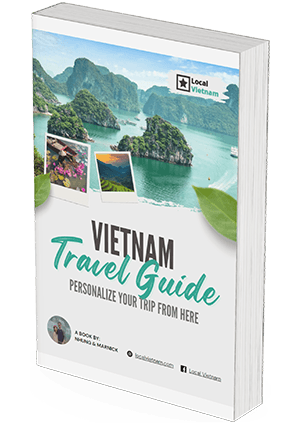What is the Hue Citadel?
The Hue Citadel is the vast outer fortress that once protected Vietnam’s imperial capital. Covering more than 500 hectares and surrounded by high walls and a wide moat, it is larger than the Hue Imperial City, which sits inside it, and the Forbidden Purple City at its core.
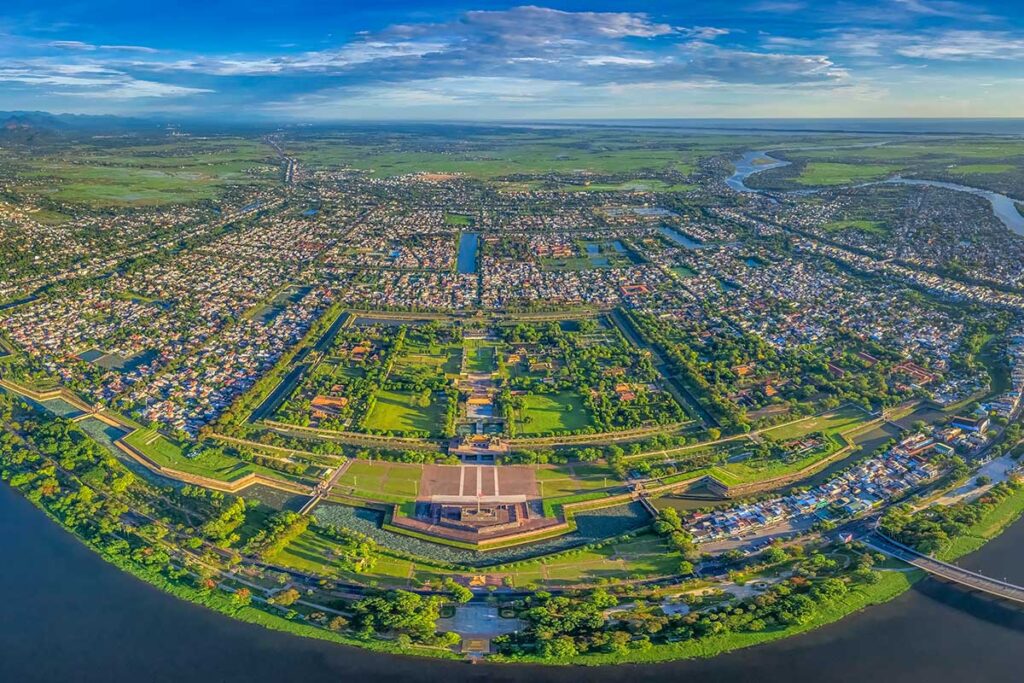
The citadel wasn’t only a royal stronghold — it also contained residential neighborhoods, markets, and administrative areas, and its many gates are still used daily by locals and tourists to move in and out of the old city. Built in the early 1800s by Emperor Gia Long as the seat of the Nguyen Dynasty, it has withstood wars, seen emperors come and go, and remains a living part of Hue’s urban life today.
Understanding the layout: Citadel, Imperial City & Forbidden Purple City
Hue’s royal complex is often referred to using different names — Hue Citadel, Imperial City, and Forbidden Purple City — but they each describe different parts of the same walled area.
- The Hue Citadel refers to the entire fortified structure, including the walls, moats, and gates.
- Inside the Citadel lies the Imperial City, where the emperor conducted state affairs, surrounded by palaces, temples, and administrative buildings.
- At the heart of it all is the Forbidden Purple City, the emperor’s private residence — a royal space once completely closed to outsiders.
If you’re looking for more detail on the palaces and life inside the walls, see our guide to the Hue Imperial City. For a deeper look at the emperor’s residence, see our article on the Forbidden Purple City.
History of the Hue Citadel
From imperial vision to royal stronghold
The Hue Citadel was built in the early 1800s under the rule of Emperor Gia Long, the first emperor of the Nguyen Dynasty. After unifying Vietnam, he moved the capital from Hanoi to Hue and ordered the construction of a massive fortified complex to protect the royal court. Inspired by Chinese imperial design and military fortresses, the citadel was carefully positioned with mountains behind and the Perfume River in front, following principles of feng shui.
Construction began in 1804 and took several decades to complete. The citadel was built with thick stone and brick walls, a surrounding moat, and 10 gates, making it one of the most secure royal strongholds in Southeast Asia. Its purpose was not just military — it enclosed the Imperial City and Forbidden Purple City, housing the emperor, his family, royal guards, mandarins, and administrative offices. During peacetime, the citadel served as a political and ceremonial center of Vietnam.
Conflict, destruction & preservation
The Hue Citadel played a key role during the Nguyen Dynasty, which ruled from 1802 to 1945. It was the seat of power for 13 emperors and the symbol of Vietnam’s imperial authority. However, it also suffered greatly during periods of conflict. The Vietnam War, especially the Tet Offensive in 1968, caused severe damage to the citadel. Many of its buildings were destroyed or heavily damaged in the fighting, and only a portion of the original structures remain today.
In recent decades, major restoration efforts have been made to preserve the Hue Citadel as part of the UNESCO World Heritage-listed Complex of Hue Monuments. While some areas are still being rebuilt, the citadel continues to stand as a powerful reminder of Vietnam’s royal past and its resilience through war.
Map of Hue Citadel
The Hue Citadel covers a massive area of over 500 hectares, enclosed by high stone walls and surrounded by a wide moat. The entire complex is laid out in a square, following ancient feng shui principles, with 10 fortified gates, defensive bastions at each corner, and broad roads leading to the Imperial City at the center. A map is helpful for understanding how the citadel, imperial city, and forbidden city fit together — and for navigating the many points of interest around the outer complex.
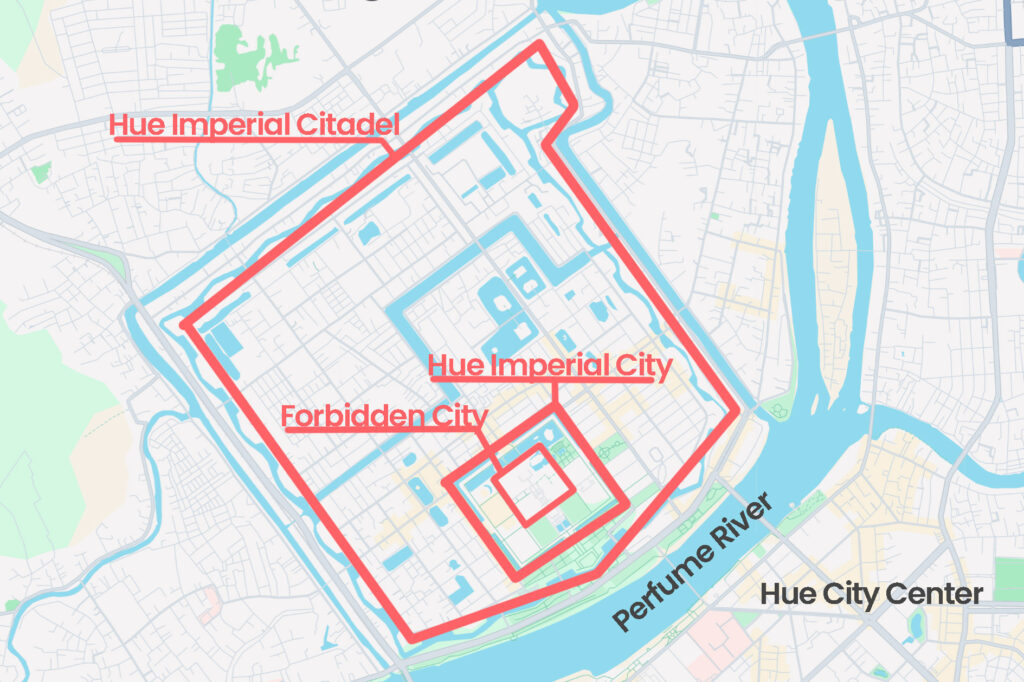
Hue Citadel Highlights & Things to see
The Hue Citadel refers specifically to the outer walled fortress that surrounds the Imperial City and the Forbidden Purple City. Built for defense and symbolism, this massive structure includes thick walls, ten fortified gates, a protective moat, and military bastions at each corner. While most travelers head straight to the inner palaces, the outer citadel holds many impressive sights of its own — from ceremonial gates to imperial cannons, watchtowers, and the city’s iconic flag tower. Below are the most interesting features to explore as you walk the citadel grounds.
1. Ngo Mon Gate – The Main Southern Entrance
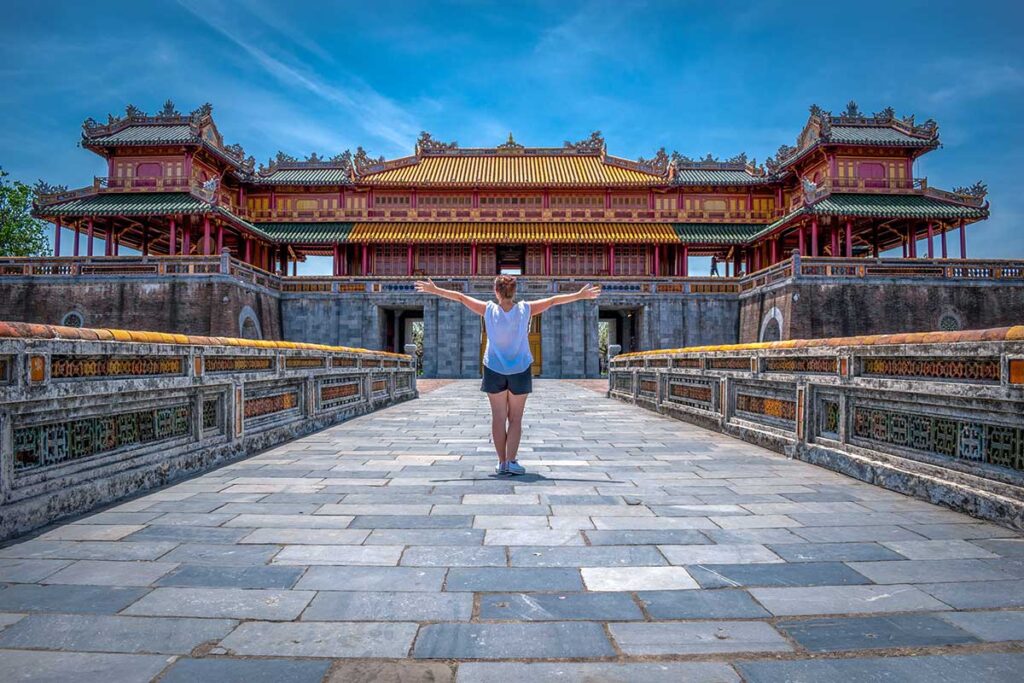
The Ngo Mon Gate is the most famous and impressive gate of the Hue Citadel. Built in 1833 under Emperor Minh Mang, it served as the main ceremonial entrance to the Imperial City. The structure features a massive stone base with five entrances, each symbolizing rank, and an elegant wooden pavilion on top known as Lầu Ngũ Phụng (The Pavilion of Five Phoenixes). This is where emperors addressed the court and watched military parades. Today, it’s the primary entry point for visitors and one of the best places to appreciate imperial architecture up close.
2. Citadel Walls & Moat – A Fortress of Power
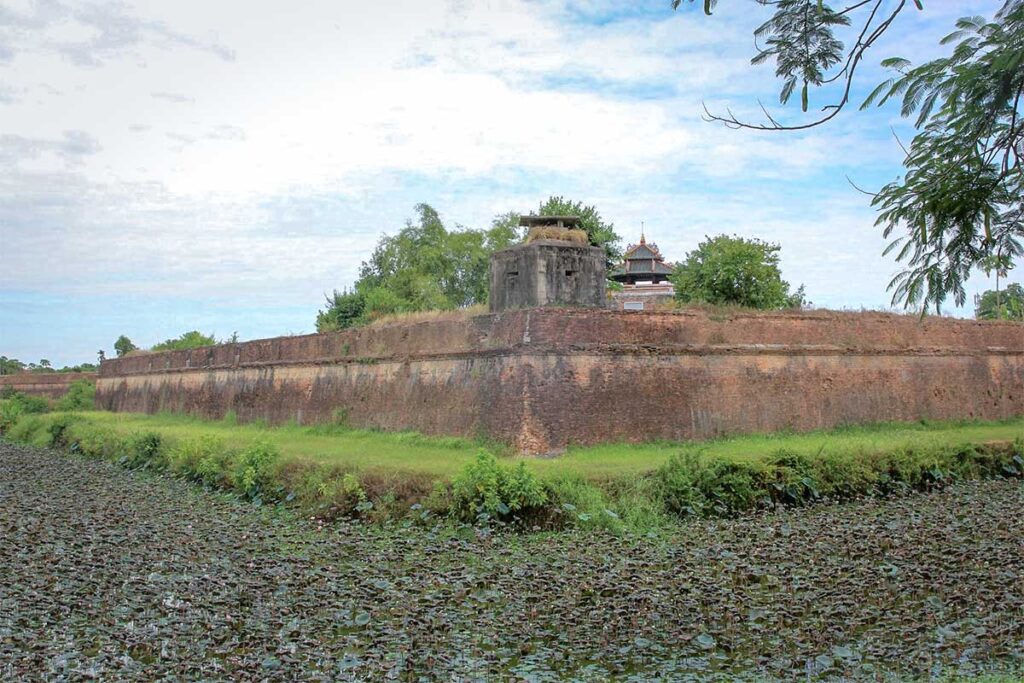
The outer walls of the Hue Citadel stretch over 10 kilometers in length and are built from bricks and packed earth, measuring about 6.6 meters high and 21 meters thick at the base. These walls were designed to withstand both natural forces and military attacks. A broad moat filled with water from the Perfume River surrounds the entire complex, adding to its defense. Walking or cycling around sections of the wall gives visitors a feel for the strategic scale and power the Nguyen emperors projected through this massive construction.
3. Ten Gates of the Citadel – Entering the Imperial Capital
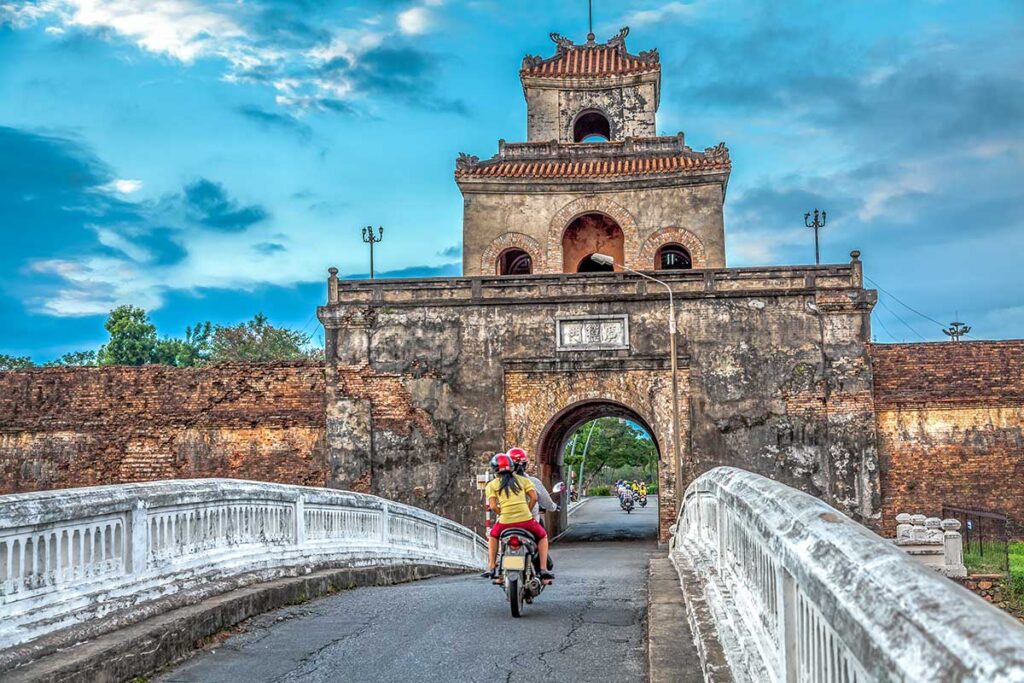
There are ten gates in total around the Hue Citadel, each with its own unique name and function. These gates controlled access to different parts of the city, and only selected individuals were allowed to pass through certain entrances depending on their rank and role. Some gates, like the Chuong Duc Gate and Hien Nhon Gate, have been restored and offer great photo opportunities with their tall arches, ornate roofs, and surviving guardhouses. They are a great example of how the citadel combined functionality with imperial symbolism.
4. Bastions & Cannon Forts – Defensive Strongholds at Every Corner


Each of the four corners of the Hue Citadel originally had military bastions for mounting cannons and defending the complex from attack. These raised platforms were part of the citadel’s strategic defense system, inspired by French and Chinese military design. While only a few remain intact today, some cannons and brick structures can still be seen, giving visitors a glimpse into how the imperial army once secured the royal capital.
5. Imperial City – The Walled City within

Located at the very center of the Citadel, the Hue Imperial City is a large, walled enclosure that contained the emperor’s court, palaces, and temples. Although it is a separate zone, it is still part of the overall citadel complex. Visitors can enter through the Ngo Mon Gate and explore highlights like the Thai Hoa Palace, The To Mieu Temple, and inner courtyards. For a deeper dive into this section, see our dedicated guide to the Hue Imperial City.
6. Flag Tower – A Symbol of Hue’s Identity
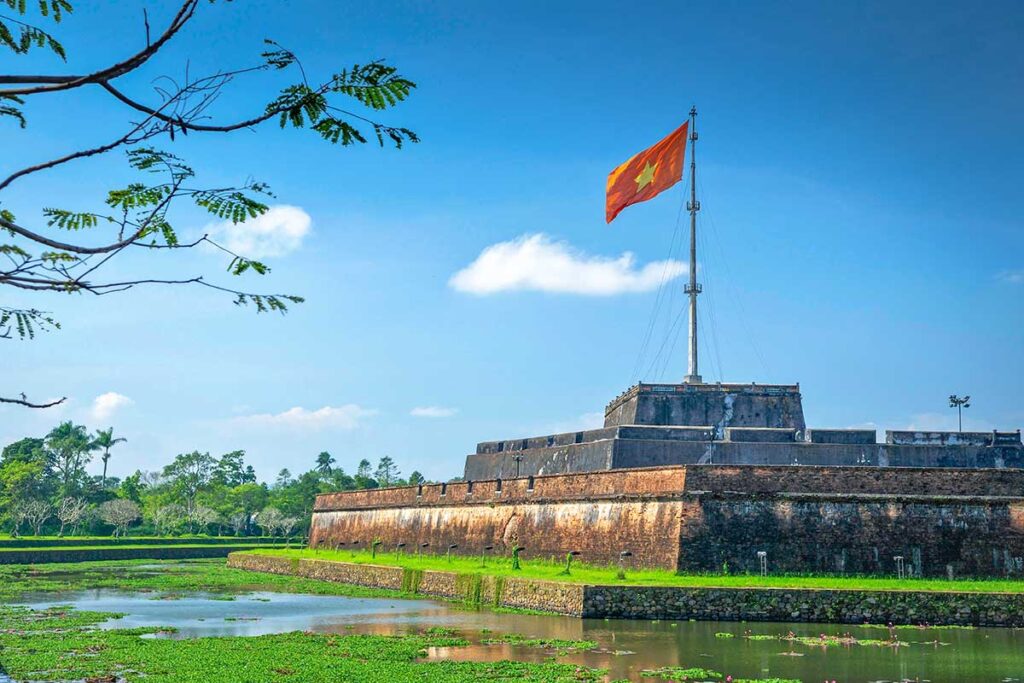
The Flag Tower (Cột Cờ) stands just in front of the Ngo Mon Gate and is one of the most recognizable symbols of Hue. Built in 1807, this three-tiered structure supports a tall flagpole that flies the Vietnamese national flag. Historically, it was used to send military signals and announce royal events. The base is made of layered stone, and visitors can walk around the tower to take in panoramic views of the surrounding walls, gates, and moat.
7. Royal Cannon Display – Guardians of the Citadel
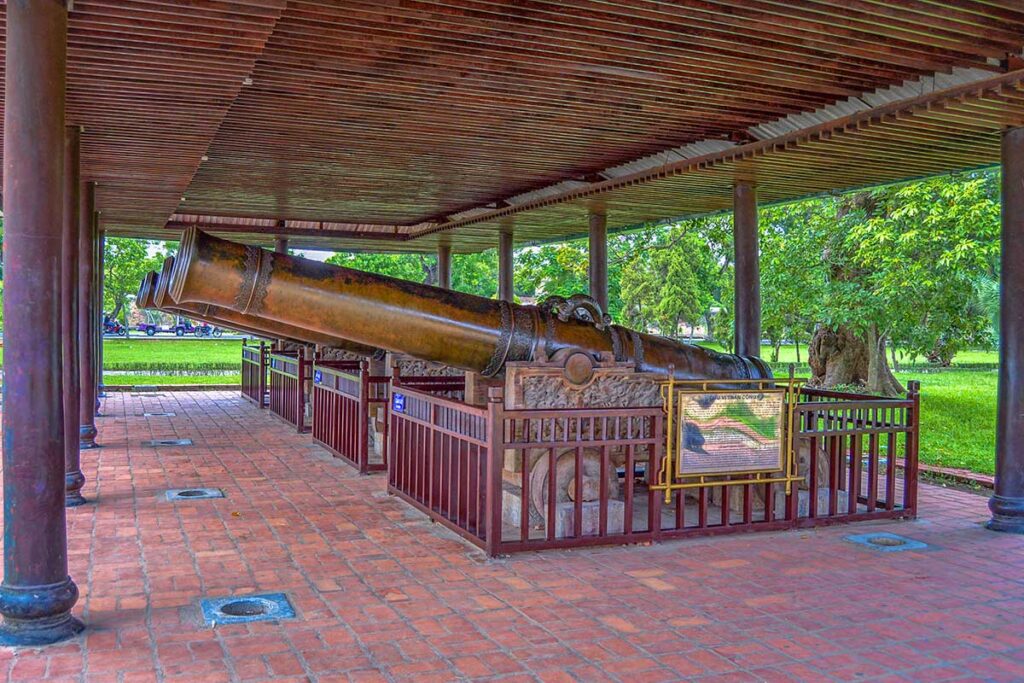
In front of the Flag Tower, you’ll find nine large bronze cannons, known as the Nine Holy Cannons, cast under Emperor Gia Long’s reign. Four face the front, representing the four seasons, and five face the sides, symbolizing the five elements in Vietnamese cosmology. Though never used in battle, these massive cannons were created to guard the citadel spiritually and are considered imperial treasures of great artistic and symbolic value.
Visiting information
Location
Thuan Hoa Ward, Hue, Vietnam — right in the city center.
Opening times
- Summer (Apr–Sep): 8:00 AM – 5:30 PM
- Winter (Oct–Mar): 7:30 AM – 5:00 PM
Open every day, including holidays.
Entrance fee
- Adults: 200,000 VND
- Children (7–12 years old): 40,000 VND
- Children under 6: Free
If you plan to visit multiple sites, including the royal tombs, consider purchasing a combo ticket that includes the Imperial City and several tombs — it’s more convenient and saves money compared to buying separate tickets at each site.
Dress code
There is no official dress code, but it’s best to dress modestly out of respect. You’re visiting a place of deep historical and cultural importance, so avoid wearing clothing that is too short or revealing.
Visiting tips
- Best time to visit: Arrive early to avoid crowds, especially on weekends and holidays. Late afternoon is quieter but leaves less time to explore.
- How long to plan: Expect to spend at least 2 hours, or up to 4 hours if you want to see the Imperial City in more detail.
- Renting royal clothes: Outfits styled after Nguyen emperors and princesses can be rented inside the Imperial City or in the city center.
- What to bring: In summer, bring water, sunscreen, and a hat. During rainy season, carry an umbrella.
- Facilities: There are toilets and a café, but no restaurants inside — avoid visiting over lunch or bring snacks.
- Guide or not?: Easy to navigate without a guide, but signage is limited. Hire a guide if you want deeper historical context.
- Taking photos: Photography is allowed in most areas. One emperor memorial temple restricts photos — signs will indicate this.
- Traditional shows: Held three times daily at the Royal Theatre if at least 10 people attend. Great way to cool off and see traditional performances.
How to get there
Hue is easily accessible by flight, bus, or train. Once you’re in the city, the Citadel is located right in the center, across the Perfume River from the main hotel area.
Walking
If you’re staying near the south bank of the river, you can walk to the citadel in about 15–25 minutes (1.5 to 2 km), depending on your hotel location. It’s a pleasant route — walk along the river, cross one of the main bridges, and you’re there. However, keep in mind that the Imperial City itself is large, so if you plan to explore extensively, you may want to save your energy for the visit itself.
Taxi or Ride-Hailing App (Grab)
The easiest and fastest way to reach the citadel. You can ask your hotel to call a taxi, but using the Grab app is often more convenient — it shows the fare upfront and lets you choose between car or motorbike options.
- From most areas in the city center: under 2 USD
- From further out: usually under 4 USD
Cyclo (Three-Wheeled Bicycle Taxi)
A traditional and charming way to get around Hue. Cyclos are often used for short sightseeing tours, but you can also hire one for a direct ride to the citadel. Expect to pay around 100,000 VND (possibly less) for a short ride, but be prepared to bargain if the initial price seems high. It’s a slow, scenic ride — perfect if you’re in no rush.
Tour option
Many visitors choose to visit the citadel as part of a guided tour — either private or group. A local guide offers deeper insight into the history and significance of the site, especially helpful since signage inside is limited. Tours often combine the Imperial City with royal tombs, Dong Ba Market, and even a dragon boat ride on the Perfume River. Most tours include hotel pickup and drop-off, making them a convenient option for travelers with limited time.
Other historic sights in Hue
While the Imperial Citadel is the centerpiece of Hue’s royal past, it’s only one part of a much larger historical landscape. As the capital of the Nguyen Dynasty, Hue was home to Vietnam’s emperors for over a century — and they left behind a legacy of temples, pagodas, and elaborate royal tombs, each with its own unique design and story. Many of these places are set in scenic natural surroundings and remain some of the most impressive sites to visit in Vietnam.
Some of the most notable sights include:
Thien Mu Pagoda
One of Hue’s most iconic religious landmarks, Thien Mu Pagoda sits on a hill overlooking the Perfume River. It’s known for its seven-tiered tower, peaceful grounds, and its important role in both religious and political history.
Tu Duc Tomb
Set among pine trees and lakes, Tu Duc Tomb is one of the most romantic and scenic tombs in Hue. Built by Emperor Tu Duc as both a retreat and final resting place, it reflects his love for poetry and nature.
Gia Long Tomb
Located further from the city center, Gia Long Tomb is the oldest of the Nguyen dynasty tombs. Its quiet rural setting and vast layout make it ideal for those seeking a peaceful, off-the-beaten-path experience.
Minh Mang Tomb
With its balanced layout and serene lotus ponds, Minh Mang Tomb is a prime example of Confucian architecture and values. It’s one of Hue’s most stately and harmonious royal tombs.
Khai Dinh Tomb
Known for its elaborate interior mosaics and fusion of Eastern and Western styles, Khai Dinh Tomb is the most unique and visually striking of the royal tombs in Hue.
Or see our full guide to the 10 Best Temples, Pagodas & Tombs in Hue

